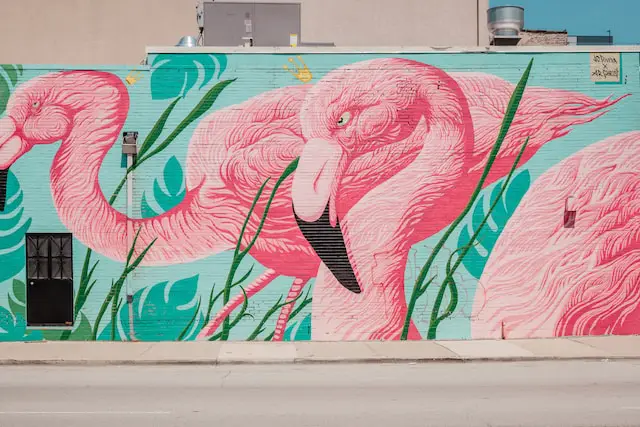Fresco and mural art are both forms of beautiful art that have been used for centuries. While frescos use wet plaster to paint directly onto a wall or ceiling, murals use several techniques to create an image on a canvas or wall. Both styles offer unique benefits depending on the type of artwork you are looking to create.
Fresco painting
(Photo by Viktor Forgacs on Unsplash )

Fresco painting is a painting technique that involves applying pigments to wet plaster so that the colors sink into the wall and become a part of it. The word “fresco” comes from the Italian word for “fresh,” and refers to the fact that the painting is done on fresh, wet plaster.
The technique of fresco painting was developed in ancient Egypt and Greece, but it was the Romans who perfected it in the 1st century BC. Frescoes were used to decorate public buildings, churches, and private homes throughout the Middle Ages and Renaissance.
To create a fresco, the wall is first coated with a layer of fresh, wet plaster, called the “intonaco.” The artist then applies pigments to the intonaco while it is still wet, working quickly to create the desired image. Because the plaster is wet, the pigments sink into it and become a part of the wall itself.
Fresco painting requires a high level of skill and precision, as the artist must work quickly before the plaster dries. Once the plaster dries, the painting is set permanently into the wall. Because of this, frescoes are incredibly durable and can last for centuries, as seen in many frescoes that still survive today.
Fresco painting has been used for a variety of purposes throughout history, including religious and political propaganda, storytelling, and decoration. Today, it continues to be used to decorate churches and public buildings, and is admired for its beauty and durability.
Mural painting
(Photo by Jonathan J. Castellon on Unsplash )

Mural painting is a form of painting that involves creating large-scale paintings directly on walls or other large surfaces. The word “mural” comes from the Latin word “murus,” which means “wall.”
Mural painting has a long history that dates back to prehistoric times. The earliest murals were found in caves, where early humans painted animals and other scenes of their daily life. Throughout history, murals have been used for a variety of purposes, including religious and political propaganda, storytelling, and decoration.
In ancient Rome, murals were used to decorate public buildings and villas. During the Renaissance, mural painting reached new heights with the work of artists such as Michelangelo, who painted the Sistine Chapel ceiling in fresco.
Today, mural painting is still widely used to beautify public spaces and promote social messages. Murals can be found on the sides of buildings, bridges, and other large structures in cities around the world. They can be created using a variety of materials, including paint, mosaic tiles, and even digital projections.
Mural painting requires a high level of skill and creativity, as the artist must work on a large scale and take into account the unique features of the surface they are painting on. They must also consider the environmental factors that can affect the longevity of the mural, such as exposure to sunlight and weather conditions.
Mural painting is a vibrant and dynamic art form that continues to evolve and inspire artists around the world. It has the power to transform public spaces and bring communities together through the beauty and message of the artwork.
The history of fresco and mural painting
Fresco and mural painting are two of the oldest forms of painting, dating back to ancient civilizations. Here is a brief history of fresco and mural painting:
Fresco Painting:
Fresco painting originated in ancient Egypt and Greece, but it was the Romans who developed the technique in the 1st century BC. The word “fresco” comes from the Italian word for “fresh,” and refers to the fact that the painting is done on fresh, wet plaster. This technique involves applying pigments to wet plaster so that the colors sink into the wall and become a part of it. Once the plaster dries, the painting is set permanently into the wall. Frescoes were used to decorate public buildings, churches, and private homes throughout the Middle Ages and Renaissance.
Mural Painting:
Mural painting has a long history that dates back to prehistoric times. The earliest murals were found in caves, where early humans painted animals and other scenes of their daily life. Throughout history, murals have been used for a variety of purposes, including religious and political propaganda, storytelling, and decoration. In ancient Rome, murals were used to decorate public buildings and villas. During the Renaissance, mural painting reached new heights with the work of artists such as Michelangelo, who painted the Sistine Chapel ceiling in fresco.
Today, both fresco and mural painting continue to be used in a variety of contexts. Frescoes are still used to decorate churches and public buildings, while murals are often used to beautify public spaces and promote social messages. The techniques have evolved over time, with modern materials and technology allowing for new possibilities in fresco and mural painting.
The difference between fresco and mural painting techniques
Fresco and mural painting are both techniques used for creating large-scale paintings on walls or other surfaces, but there are some key differences between the two methods.
Fresco painting involves applying pigments to wet plaster so that the colors sink into the wall and become a part of it. The plaster is applied in thin layers, and each layer is allowed to dry slightly before the next layer is added. Because the pigments are absorbed into the wet plaster, frescoes have a matte finish and the colors are not as vibrant as those in oil or acrylic paintings. Frescoes are also highly durable and can last for centuries, as seen in many frescoes that still survive today.
Mural painting, on the other hand, involves applying paint directly onto a wall or other large surface. Unlike fresco painting, mural painting can be done on any surface that can be painted, including drywall, brick, and concrete. The artist can use any type of paint, including oil or acrylic, which allows for a wider range of colors and effects than fresco painting. However, murals are generally less durable than frescoes and can be more susceptible to fading, peeling, or damage from weather or other environmental factors.
Another key difference between the two techniques is the level of planning and preparation required. Fresco painting requires a high level of planning and precision, as the artist must work quickly and methodically before the plaster dries. Mural painting, on the other hand, allows for more spontaneity and experimentation, as the artist can work directly on the surface and make adjustments as they go.
Overall, both fresco and mural painting are unique and dynamic art forms that have been used throughout history to decorate public spaces, convey messages, and inspire awe and wonder in viewers. While they differ in their techniques and requirements, both techniques continue to be used by artists around the world to create stunning and memorable works of art.
The different styles of fresco and mural painting
Fresco and mural painting are versatile art forms that have been used throughout history to express a wide range of styles, themes, and techniques. Here are some of the different styles of fresco and mural painting:
Classical Style: This style is characterized by realistic depictions of human figures and scenes from classical mythology or history. This style was popular in ancient Rome and Greece and was revived during the Renaissance.
Baroque Style: This style is characterized by dramatic and ornate compositions, often featuring religious or mythological subjects. It was popular in Europe during the 17th and 18th centuries and is known for its bold colors and dynamic compositions.
Realism Style: This style is characterized by a focus on depicting scenes from everyday life with a high degree of accuracy and detail. Realism was popular in the 19th century and is known for its use of light and shadow to create a sense of depth and realism.
Surrealism Style: This style is characterized by dreamlike and fantastical compositions that challenge traditional notions of reality. Surrealist murals often feature unexpected juxtapositions of objects or figures, creating a sense of disorientation and intrigue.
Graffiti Style: This style is characterized by bold, colorful designs and lettering, often featuring social or political messages. Graffiti murals can be found in cities around the world and are known for their vibrant energy and street-inspired aesthetic.
Abstract Style: This style is characterized by non-representational forms, colors, and shapes that create a sense of movement and energy. Abstract murals often feature bold, vibrant colors and dynamic compositions that challenge traditional notions of form and space.
Fresco and mural painting offer a wide range of styles and techniques for artists to explore, making them dynamic and versatile art forms that continue to inspire and captivate viewers.
Featured Image By – Nick Fewings on Unsplash








